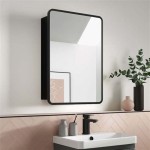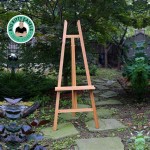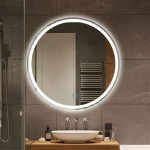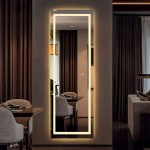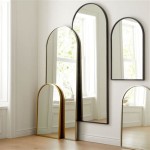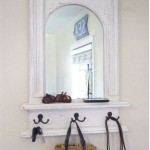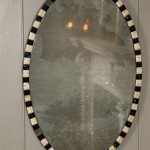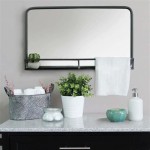How To Mount Beveled Mirror
Beveled mirrors, with their elegant, faceted edges, add a touch of sophistication to any room. Whether you're installing a small accent mirror or a large statement piece, mounting it securely and correctly is crucial for both aesthetics and safety. This article will guide you through the process of mounting a beveled mirror, outlining essential steps and considerations for a successful installation.
Choosing the Right Mounting Method
The method you choose to mount your beveled mirror will depend on its size, weight, and the wall material. Here’s a breakdown of common methods and their suitability:
- Adhesive Mounting: Ideal for smaller and lighter mirrors, especially those made of acrylic or lightweight glass. Many adhesive strips are specifically designed for mirrors and offer a strong bond. However, they may not be suitable for heavier, larger mirrors or those in high-traffic areas.
- D-Ring Hangers: D-rings are versatile and commonly used for mounting mirrors. They are attached to the back of the mirror and secured to the wall with picture wire or string. This method allows for easy adjustment and leveling. However, it may require drilling into the wall.
- Mirror Clips: Mirror clips are small, discreet clips that attach to the back of the mirror and secure to the wall with screws. They are suitable for both lightweight and heavier mirrors but may leave small holes on the wall.
- Heavy-Duty Hanging System: For large, heavy mirrors, a dedicated heavy-duty hanging system is recommended. These systems typically involve using thick wire or a specialized hanging track, offering superior strength and stability.
Preparing for Installation
Before mounting your beveled mirror, careful preparation is key to a smooth and successful installation:
- Choose the Mounting Location: Carefully consider the desired location for your mirror. Ensure it is level, free from obstructions, and provides adequate support for the weight. You may want to mark the location with a pencil or masking tape.
- Gather Tools and Materials: Assemble the necessary tools and materials, including a level, measuring tape, pencil, drill (for most methods), screws, wall anchors (for plaster or drywall), picture wire or string (for D-ring hangers), and the chosen mounting system.
- Prepare the Wall: Clean the wall surface thoroughly to ensure proper adhesion. If necessary, use a stud finder to locate wall studs for added stability, especially for heavy mirrors. Fill any holes or cracks with spackle and allow it to dry completely.
Mounting the Mirror
The specific steps involved in mounting your beveled mirror will vary depending on the chosen method. However, these general guidelines are applicable across most installations:
- Attach the Mounting Hardware: Using the appropriate tools, attach the chosen mounting hardware to the back of the mirror according to the manufacturer’s instructions. Ensure the hardware is securely fastened and evenly spaced.
- Mark the Wall: Carefully mark the wall where the mounting hardware will be attached. This will help ensure your mirror is level and centered. Use a level to ensure the markings are perfectly horizontal.
- Drill Holes (if necessary): If you are using D-ring hangers, mirror clips, or a heavy-duty hanging system, you will likely need to drill pilot holes into the wall. Use a drill bit that is slightly smaller than the screw diameter. If your wall is plaster or drywall, you may need to use wall anchors for added support.
- Secure the Mirror: Carefully hang the mirror onto the mounting hardware. Ensure the mirror is securely attached and level. If necessary, tighten screws or adjust the hanging wire to achieve a stable and level installation.
Important Considerations
While following these steps is essential for a successful installation, some additional considerations can enhance the process:
- Mirror Weight and Size: Always consider the mirror's weight and size when choosing a mounting method. A lightweight mirror can usually be mounted with adhesive or simple hardware, while a heavier mirror may require a more robust system.
- Wall Material: The type of wall material will affect the mounting method. Drywall and plaster walls necessitate different techniques and materials compared to concrete or brick walls.
- Safety: Ensure the mirror is securely attached and cannot easily fall. If you're hanging a large or heavy mirror, consider using multiple mounting points for added safety.
- Level and Alignment: Take extra care to ensure the mirror is perfectly level and aligned. Using a level and multiple measuring points will help achieve a visually appealing and professional-looking installation.

How To Install A Beveled Mirror Dulles Glass

How To Hang A Heavy Full Length Leaner Mirror On The Wall House Of Hepworths

Beveled Mirror Clip Set 5 8 Wide Chrome

Beveled Mirror Clip Set 5 8 Wide Brushed Nickel

Decor Wonderland Vera 23 6 In W X 39 5 H Large Rectangular Frameless Beveled Wall Mount Bathroom Vanity Mirror Silver Dwsm216l The Home Depot

Better Bevel 24 In W X 30 H Frameless Rectangular Beveled Edge Bathroom Vanity Mirror 17151 The Home Depot

Hamilton Hills 24 X 36 Frameless Rectangular Beveled Mirror Target

Galvin 24 X 36 Frameless Beveled Wall Mirror P1400 Lamps Plus

Head West Brushed Chrome Framed Bathroom Mirror Beveled Edge Rectangle Vanity Modern Living Room Accent And Home Decor With Vertical Horizontal Mount 24 X 30 Com

Beveled Glass Frame Mirror Pottery Barn

